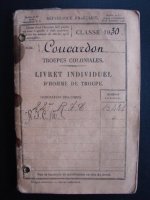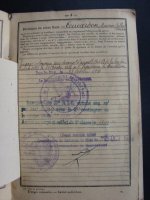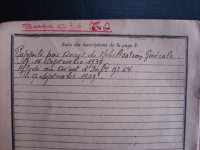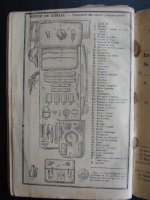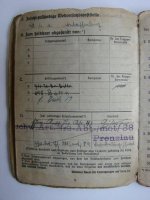Most of you most likely saw the movie "Dunkirk" last year and because this week I came across a French ID booklet of a soldier that was KIA in the defence of the Dunkirk perimeter, I presume their is some interest on this forum for this soldiers "petit histoire" in a historical battle.
Coucardon Maurice (1912-1940) from Verdun joined the French army as a volunteer in 1931, he served one year with the 22th Colonial Infantry Regiment and returned to his civilian job as an accountant.
On September 16 1939, two weeks after the declaration of war, Coucardon Maurice was mobilized and sent to the Infantry Depot #64, in December 1939 he is transferred to the 4th company of the 150th motorized infantry regiment (150 RIM), a regiment with soldiers from the Verdun area, of the 12th DIM (motorized infantry division).
The 12DIM is one of the divisions of the General Blanchard's First Army, the strongest French army, in case of a German invasion its task is to move in to Belgium and to occupy the so called Gembloux gap, an open plain in the middle of Belgium between Brussels and Namur, ideal for tank warfare and the allies expect the main body of the German army to invade through this gap.
When on May 10 1940 the Germans invade, 12DIM moves north to the Gembloux gap but the Germans don't play by the allied scenario, their are only two of the ten German armoured divisions there, the main body is way more south in the Ardennes and when the allied leaders notice their mistake it is to late, the divisions of the First Army have manoeuvred themselves in to a trap.
Under constant bombardments of the Luftwaffe they retreat back to France but 1940 isn't 1914, it is Blitzkrieg now and their is no time to reorganize for a counter offensive on the German flank, instead the 12DIM retreats to the sea.
But their will not be a rescue operation for the men of the 12DIM, they will stay and defend the Dunkirk perimeter to allow the BEF to escape.
The 150RIM will defend Ghyvelde, this is on the eastern edge of the perimeter on the Belgian-Franco border between the dunes and a marsh more inland; when the BEF has completed their rescue mission from the Belgian beaches between Nieuwpoort and La Panne on May 31 1940 the Germans squeeze the pocket even smaller.
On June 2 1940 the Germans once again order a big offensive on the sector held by Coucardon Maurice and his fellow soldiers, the 56ID alone has 33 artillery batteries at his disposal to bombard their sector to support one of its three infantry regiments that will have to attack the French frontline; it is during this barrage that Maurice gets severely wounded, he is evacuated to the sanatorium of Zuydcote, where he will pass away on June 4 1940.
Also his division commander General Janssen is KIA on June 2 1940.
Maurice Coucardon is still buried in the French army cemetery in Zuydcote.
A map of the Dunkirk perimeter:
Coucardon Maurice (1912-1940) from Verdun joined the French army as a volunteer in 1931, he served one year with the 22th Colonial Infantry Regiment and returned to his civilian job as an accountant.
On September 16 1939, two weeks after the declaration of war, Coucardon Maurice was mobilized and sent to the Infantry Depot #64, in December 1939 he is transferred to the 4th company of the 150th motorized infantry regiment (150 RIM), a regiment with soldiers from the Verdun area, of the 12th DIM (motorized infantry division).
The 12DIM is one of the divisions of the General Blanchard's First Army, the strongest French army, in case of a German invasion its task is to move in to Belgium and to occupy the so called Gembloux gap, an open plain in the middle of Belgium between Brussels and Namur, ideal for tank warfare and the allies expect the main body of the German army to invade through this gap.
When on May 10 1940 the Germans invade, 12DIM moves north to the Gembloux gap but the Germans don't play by the allied scenario, their are only two of the ten German armoured divisions there, the main body is way more south in the Ardennes and when the allied leaders notice their mistake it is to late, the divisions of the First Army have manoeuvred themselves in to a trap.
Under constant bombardments of the Luftwaffe they retreat back to France but 1940 isn't 1914, it is Blitzkrieg now and their is no time to reorganize for a counter offensive on the German flank, instead the 12DIM retreats to the sea.
But their will not be a rescue operation for the men of the 12DIM, they will stay and defend the Dunkirk perimeter to allow the BEF to escape.
The 150RIM will defend Ghyvelde, this is on the eastern edge of the perimeter on the Belgian-Franco border between the dunes and a marsh more inland; when the BEF has completed their rescue mission from the Belgian beaches between Nieuwpoort and La Panne on May 31 1940 the Germans squeeze the pocket even smaller.
On June 2 1940 the Germans once again order a big offensive on the sector held by Coucardon Maurice and his fellow soldiers, the 56ID alone has 33 artillery batteries at his disposal to bombard their sector to support one of its three infantry regiments that will have to attack the French frontline; it is during this barrage that Maurice gets severely wounded, he is evacuated to the sanatorium of Zuydcote, where he will pass away on June 4 1940.
Also his division commander General Janssen is KIA on June 2 1940.
Maurice Coucardon is still buried in the French army cemetery in Zuydcote.
A map of the Dunkirk perimeter:




